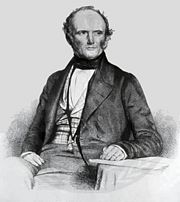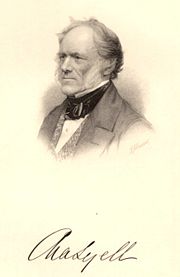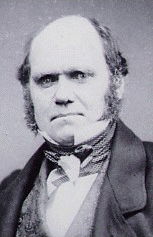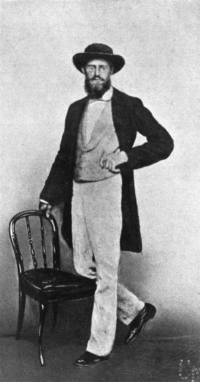Charles Lyell
| Sir Charles Lyell, Bt | |
 Sir Charles Lyell
|
|
| Born | November 14, 1797 Kinnordy, Forfarshire |
|---|---|
| Died | February 22, 1875 Harley Street, London, England |
| Nationality | British |
| Fields | geology |
| Known for | Uniformitarianism |
| Influences | James Hutton & John Playfair; William Buckland |
| Influenced | Charles Darwin, Alfred Russel Wallace, Thomas Henry Huxley |
| Notable awards | Copley Medal |
Sir Charles Lyell, 1st Baronet, KT, FRS (14 November 1797 – 22 February 1875) was a Scottish lawyer, geologist, and protagonist of uniformitarianism. He was the foremost geologist of his day, and an influence on the young Charles Darwin.
Contents |
Life
Charles Lyell was born in Kinnordy, Forfarshire (now Angus), the eldest of ten children. Lyell's father, also named Charles, was a lawyer and botanist of minor repute and first exposed the younger Charles to the study of nature. Charles spent much of his childhood at the family’s other home, Bartley Lodge in the New Forest, England, where his interest in the natural world was sparked.
After being sent down from Exeter College, Oxford in 1820, Lyell learnt geology under the wing of the naturalist William Buckland.[1] After graduation he took up law as a profession, and completed a circuit through rural England, where he could observe geology. As his eyesight began to fail him he turned to geology as a full time profession.[1] His first paper, "On a recent formation of freshwater limestone in Forfarshire", was presented in 1822.[1] By 1827, he had abandoned the law and embarked on a geological career that would result in fame and the acceptance of ideas, mainly uniformitarianism, proposed by James Hutton a few decades earlier.
In 1832, Lyle married Mary Horner of Bonn, daughter of Leonard Horner (1785-1864), also associated with the Geological Society of London. The new couple spent their honeymoon in Switzerland and Italy on a geological tour of the area.[2]
During the 1840s, he traveled to the United States and Canada, and wrote two popular travel-and-geology books: Travels in North America (1845) and A Second Visit to the United States (1849). After the Great Chicago Fire, Lyell was one of the first to donate books to help found the Chicago Public Library.
Lyell's wife Mary died in 1873, and two years later Lyell himself died as he was revising the twelfth edition of Principles. He is buried in Westminster Abbey.[2] Lyell was rewarded by the State with a knighthood (KT), and later by a baronetcy (Bt), which is an hereditary honour. He was awarded the Copley Medal in 1858 and the Wollaston Medal in 1866. Lyell crater on the Moon and a crater on Mars were named in his honour. In addition, Mount Lyell in western Tasmania, Australia, located in a profitable mining area, bears Lyell’s name.
Career and major writings

Lyell had private means, and earnt further income as an author. He came from a prosperous family, worked briefly as a lawyer in the 1820s, and held the post of Professor of Geology at King's College London in the 1830s. From 1830 onward his books provided both income and fame. Each of his three major books was a work continually in progress. All three went through multiple editions during his lifetime, Though many of his friends (such as Darwin) thought the first edition of the Principles was the best written.[3] Lyell used each edition to incorporate additional material, rearrange existing material, and revisit old conclusions in light of new evidence.
Principles of Geology, Lyell's first book, was also his most famous, most influential, and most important. First published in three volumes in 1830-33, it established Lyell's credentials as an important geological theorist and propounded the doctrine of uniformitarianism[4] It was a work of synthesis, backed by his own personal observations on his travels.

The central argument in Principles was that "the present is the key to the past". Geological remains from the distant past can, and should, be explained by reference to geological processes now in operation and thus directly observable. Lyell's interpretation of geologic change as the steady accumulation of minute changes over enormously long spans of time was a powerful influence on the young Charles Darwin. Lyell asked Robert FitzRoy, captain of HMS Beagle, to search for erratic boulders on the survey voyage of the Beagle, and just before it set out FitzRoy gave Darwin Volume 1 of the first edition of Lyell's Principles. When the Beagle made its first stop ashore at St Jago Darwin found rock formations which seen "through Lyell's eyes" gave him a revolutionary insight into the geological history of the island, an insight he applied throughout his travels.
While in South America Darwin received Volume 2 which considered the ideas of Lamark in some detail. Lyell rejected Lamark's idea of organic evolution, proposing instead "Centres of Creation" to explain diversity and territory of species. However, as discussed below, many of his letters show he was fairly open to the idea of evolution.[5] In geology Darwin was very much Lyell's disciple, and brought back observations and his own original theorising, including ideas about the formation of atolls, which supported Lyell's uniformitarianism. On the return of the Beagle (October 1836) Lyell invited Darwin to dinner and from then on they were close friends. Although Darwin discussed evolutionary ideas with him from 1842, Lyell continued to reject evolution in each of the first nine editions of the Principles. He encouraged Darwin to publish, and following the 1859 publication of On the Origin of Species, Lyell finally offered a tepid endorsement of evolution in the tenth edition of Principles.
Elements of Geology began as the fourth volume of the third edition of Principles: Lyell intended the book to act as a suitable field guide for students of geology.[6]. The systematic, factual description of geological formations of different ages contained in Principles grew so unwieldy, however, that Lyell split it off as the Elements in 1838. The book went through six editions, eventually growing to two volumes and ceasing to be the inexpensive, portable handbook that Lyell had originally envisioned. Late in his career, therefore, Lyell produced a condensed version titled Student's Elements of Geology that fulfilled the original purpose.
Geological Evidences of the Antiquity of Man brought together Lyell's views on three key themes from the geology of the Quaternary Period of Earth history: glaciers, evolution, and the age of the human race. First published in 1863, it went through three editions that year, with a fourth and final edition appearing in 1873. The book was widely regarded as a disappointment because of Lyell's equivocal treatment of evolution. Lyell, a devout Christian, had great difficulty reconciling his beliefs with natural selection.[7]
Scientific contributions
Lyell's geological interests ranged from volcanoes and geological dynamics through stratigraphy, paleontology, and glaciology to topics that would now be classified as prehistoric archaeology and paleoanthropology. He is best known, however, for his role in popularising the doctrine of uniformitarianism.
Uniformitarianism
From 1830 to 1833 his multi-volume Principles of Geology was published. The work's subtitle was "An attempt to explain the former changes of the Earth's surface by reference to causes now in operation", and this explains Lyell's impact on science. He drew his explanations from field studies conducted directly before he went to work on the founding geology text.[1] He was, along with the earlier John Playfair, the major advocate of James Hutton's idea of uniformitarianism, that the earth was shaped entirely by slow-moving forces still in operation today, acting over a very long period of time. This was in contrast to catastrophism, a geologic idea of abrupt changes due to unknown forces, which had been adapted in England to support belief in Noah's flood. The two terms, uniformitarianism and catastrophism, were coined by William Whewell; in 1866 R. Grove suggested the simpler term continuity for Lyells's view, but the old terms persisted. In various revised editions (twelve in all, through 1872), Principles of Geology was the most influential geological work in the middle of the 19th century, and did much to put geology on a modern footing. For his efforts he was knighted in 1848, then made a baronet in 1864.
Geological Surveys
Lyell noted the “economic advantages” that geological surveys could provide, citing their felicity in mineral-rich countries and provinces. Modern surveys, like the U.S. Geological Survey, map and exhibit the natural resources within the country. So, in endorsing surveys, as well as advancing the study of geology, Lyell helped to forward the business of modern extractive industries, such as the coal and oil industry.
Volcanoes and geological dynamics

Before the work of Lyell, phenomena such as earthquakes were understood by the destruction that they wrought. One of the contributions that Lyell made in Principles was to explain the cause of earthquakes.[8] Lyell, in contrast focused on recent earthquakes (150 yrs), evidenced by surface irregularities such as faults, fissures, stratigraphic displacements and depressions.[8]
Lyell's work on volcanoes focused largely on Vesuvius and Etna, both of which he had earlier studied. His conclusions supported gradual building of volcanoes, so-called "backed up-building,"[6] as opposed to the upheaval argument supported by other geologists.
Stratigraphy
Lyell's most important specific work was in the field of stratigraphy. From May 1828, until February 1829, he traveled with Roderick Impey Murchison (1792-1871) to the south of France (Auvergne volcanic district) and to Italy.[6][9][2] In these areas he concluded that the recent strata (rock layers) could be categorized according to the number and proportion of marine shells encased within. Based on this he proposed dividing the Tertiary period into three parts, which he named the Pliocene, Miocene, and Eocene.
Glaciers

In Principles of Geology (first edition, vol. 3, Ch. 2, 1833)[2] Lyell proposed that icebergs could be the means of transport for erratics. During periods of global warming, ice breaks off the poles and floats across submerged continents, carrying debris with it, he conjectured. When the iceberg melts, it rains down sediments upon the land. Because this theory could account for the presence of diluvium, the word "drift" became the preferred term for the loose, unsorted material, today called "till." Furthermore, Lyell believed that the accumulation of fine angular particles covering much of the world (today called loess) was a deposit settled from mountain flood water. Today some of Lyell's mechanisms for geologic processes have been disproven, though many have stood the test of time.[1] His observational methods and general analytical framework remain in use today as foundational principles in geology.[1]
Evolution
Lyell first became aware of the ideas of Jean-Baptiste Lamarck when he was 26, in 1827. A letter to Mantell reads, in part, as follows:
- "I devoured Lamark... his theories delighted me... I am glad that he has been courageous enough and logical enough to admit that his argument, if pushed as far as it must go, if worth anything, would prove that men may have come from the Ourang-Outang. But after all, what changes species may really undergo!... That the Earth is quite as old as he supposes, has long been my creed..." [10]

In the second volume of the first edition of Principles Lyell explicitly rejected the mechanism of Lamark on the transmutation of species, and was doubtful whether species were mutable.[11] However, privately, in letters, he was more open to the possibility of evolution:
- "If I had stated... the possibility of the introduction or origination of fresh species being a natural, in contradisctinction to a miraculous process, I should have raised a host of prejudices against me, which are unfotunately opposed at every step to any philosopher who attempts to address the public on these mysterious subjects." [12]
This letter makes it clear that his equivocation on evolution was, at least at first, a deliberate tactic. As a result of his letters and, no doubt, personal conversations, Huxley and Haeckel were convinced that, at the time he wrote Principles, he believed new species had arisen by natural methods. Both Whewell and Sedgwick wrote worried letters to him about this.[13]
Later, Darwin became a close personal friend, and Lyell was one of the first scientists to support On the Origin of Species, though he did not subscribe to all its contents. Lyell was also a friend of Darwin's closest colleagues, Hooker and Huxley, but unlike them he struggled to square his religious beliefs with evolution. This inner struggle has been much commented on. He had particular difficulty in believing in natural selection as the main motive force in evolution.[14][15][16]

Lyell and Hooker were instrumental in arranging the peaceful co-publication of the theory of natural selection by Darwin and Alfred Russel Wallace in 1858: each had arrived at the theory independently (Darwin long before Wallace, however). Lyell's data on stratigraphy were important because Darwin thought that populations of an organism changed slowly, requiring "geologic time".
Although Lyell did not publicly accept evolution (descent with modification) at the time of writing the Principles,[17] after the Darwin-Wallace papers and the Origin Lyell wrote in his notebook:
- May 3 1860: "Mr. Darwin has written a work which will constitute an era in geology & natural history to show that... the descendants of common parents may become in the course of ages so unlike each other as to be entitled to rank as a distinct species, from each other or from some of their progenitors." [18]
Lyell's acceptance of natural selection, Darwin's proposed mechanism for evolution, was equivocal, and came in the tenth edition of Principles.[1][19] The Antiquity of Man (published in early February 1863, just before Huxley's Man's place in nature) drew these comments from Darwin to Huxley:
- "I am fearfully disappointed at Lyell's excessive caution" and "The book is a mere 'digest' ".[20]
Quite strong remarks: no doubt Darwin resented Lyell's repeated suggestion that he owed a lot to Lamarck, whom he (Darwin) had always specifically rejected. Darwin's daughter Henrietta (Etty) wrote to her father: "Is it fair that Lyell always calls your theory a modification of Lamarck's?" [21][22]
In other respects Antiquity was a success. It sold well, and it "shattered the tacit agreement that mankind should be the sole preserve of theologians and historians." [23] But when Lyell wrote that it remained a profound mystery how the huge gulf between man and beast could be bridged, Darwin wrote "Oh!" in the margin of his copy. [24]
Bibliography
Principles of Geology
- Principles of Geology 1st vol. 1st edition, Jan. 1830 (John Murray, London).
- Principles of Geology 1st vol. 2nd edition, 1832
- Principles of Geology 2nd vol. 1st edition, Jan. 1832
- Principles of Geology 2nd vol. 2nd edition, Jan. 1833
- Principles of Geology 3rd vol. 1st edition, May 1833
- Principles of Geology 4 vols. 3rd edition, May 1834
- Principles of Geology 4 vols. 4th edition, June 1835
- Principles of Geology 4 vols. 5th edition, March 1837
- Principles of Geology 3 vols. 6th edition, June 1840
- Principles of Geology 1 vol. 7th edition, Feb. 1847
- Principles of Geology 1 vol. 8th edition, May 1850
- Principles of Geology 1 vol. 9th edition, June 1853
- Principles of Geology 10th edition, 1866-68
- Principles of Geology 2 vols. 11th edition, 1872
- Principles of Geology 2 vols. 12th edition, 1875 (published posthumously)
Elements of Geology
- Elements of Geology 1 vol. 1st edition, July 1838 (John Murray, London)
- Elements of Geology 2 vols. 2nd edition, July 1841
- Elements of Geology (Manual of Elementary Geology) 1 vol. 3rd edition, Jan. 1851
- Elements of Geology (Manual of Elementary Geology) 1 vol. 4th edition, Jan. 1852
- Elements of Geology 1 vol. 5th edition, ????
- Elements of Geology 6th edition, 1865
- Student's Elements of Geology, 1871
Travels in North America
- Travels in North America 2 vols., 1845 (John Murray, London)
- A Second Visit to the United States of North America 2 vols., 1849 (John Murray, London)
Antiquity of Man
- Geological Evidences of the Antiquity of Man 1 vol. 1st edition, Feb. 1863 (John Murray, London)
- Geological Evidences of the Antiquity of Man 1 vol. 2nd edition, April 1863
- Geological Evidences of the Antiquity of Man 1 vol. 3rd edition, Nov. 1863
- Geological Evidences of the Antiquity of Man 1 vol. 4th edition, May 1873
Life, Letters, and Journals
- Life, Letters, and Journals of Sir Charles Lyell 2 vols. 1st edition, K. M. Lyell, ed., 1881 (John Murray, London)
Miscellaneous
Lyell Land in East Central Greenland is named after him.
See also
- Correspondence of Charles Darwin
- Shen Kuo, 11th century Chinese geologist and mineralogist
Image source
- Portraits of Honorary Members of the Ipswich Museum (Portfolio of 60 lithographs by T.H. Maguire) (George Ransome, Ipswich 1846-1852)
References
- ↑ 1.0 1.1 1.2 1.3 1.4 1.5 1.6 Wilson, Leonard G. "Charles Lyell" Dictionary of Scientific Biography. Ed. Charles Coulston Gillispie. Vol. VIII. Pennsylvania, Charles Scribner's Sons, 1973.
- ↑ 2.0 2.1 2.2 2.3 Macomber, Richard W. "Lyell, Sir Charles, Baronet." The New Encyclopedia Britannica, Encyclopedia Britannica, Inc., 1997.
- ↑ Darwin F. 1887. Life and letters of Charles Darwin, vol II p90. London. Darwin F and Seward A.C. 1903. More letters of Charles Darwin, vol II p232. London.
- ↑ http://evolution.berkeley.edu/evolibrary/article/_0/history_12. Accessed 27 Nov. 2007.
- ↑ Judd gives a number of examples: Judd J.W. 1910. The coming of evolution. Cambridge.
- ↑ 6.0 6.1 6.2 Bailey, Edward 1962. Charles Lyell. Nelson, London.
- ↑ Bynum W.F. 1984. Charles Lyell's Antiquity of Man and its critics. J. Hist Biol 17 153-87.
- ↑ 8.0 8.1 Adams, Frank D. The Birth and Development of the Geological Sciences. Dover Publications, Inc., 1938.
- ↑ Stafford, Robert A. Scientist of Empire. Cambridge, UK. Cambridge University Press, 1989.
- ↑ Lyell K. 1881. The life and letters of Sir Charles Lyell. 2 vols, London. vol 1 p168
- ↑ Lyell C. 1830-33. The principles of geology. Murray, London. vol 2, Chapter 2.
- ↑ Lyell K. 1881. The life and letters of Sir Charles Lyell. 2 vols, London. vol 2 p5
- ↑ see Judd J.W. 1910. The coming of evolution. Cambridge. Chapter 8, p83-6.
- ↑ Bowler P.J. 2003. Evolution: the history of an idea. 3rd ed, California. 129-134, 215
- ↑ Mayr E. 1982. The growth of biological thought. Harvard. (esp pp375-381 & 404-8).
- ↑ Bartholomew M. 1973. Lyell and evolution: an account of Lyell's response to the prospect of an evolutionary ancestry for man. Brit J Hist Sci 6, 261-303.
- ↑ Lyell C. 1830-33. The principles of geology. Murray, London. vol 2, 20-21.
- ↑ Wilson, Leonard G. (ed) 1970. Sir Charles Lyell's scientific journals on the species question. Yale University Press. p407
- ↑ Desmond A. 1982. Archetypes and Ancestors: palaeontology in Victorian London Blond & Briggs, London. page 179: "Even Charles Lyell agreed... that 'natural selection was a force quite subordinate to that variety-making or creative power to which all the wonders of the organic world must be referred.' "
- ↑ Burkhardt F. and Smith S. 1982–present. The correspondence of Charles Darwin. Cambridge, vol 11, 181 & 173.
- ↑ Burkhardt F. and Smith S. 1982–present. The correspondence of Charles Darwin. Cambridge, vol 11, 223.
- ↑ Cape, ISBN 1-84413-314-1 Browne, E. Janet 2002. Charles Darwin: the power of place. Volume 2 of a biography. Cape, London. p219
- ↑ Browne, E. Janet 2002. Charles Darwin: the power of place. Volume 2 of a biography. Cape, London. p218
- ↑ Bynum W.F. 1984. Charles Lyell's Antiquity of Man and its critics. J. Hist Biol 17 153-87.
External links
- Charles Lyell Notable Names Database.
- Charles Lyell in Strange Science
- Elements of Geology, The Student's Series, 1871
- Principles of Geology 1st edition at ESP: Electronic Scholarly Publishing. Retrieved on August 8, 2007
- Works by Charles Lyell at Project Gutenberg
| Baronetage of the United Kingdom | ||
|---|---|---|
| New creation | Baronet (of Kinnordy) 1864 – 1875 |
Extinct |